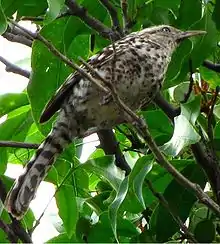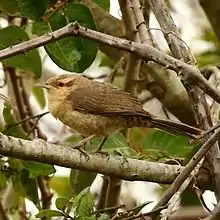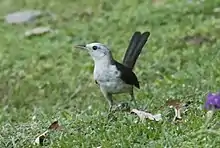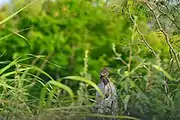Campylorhynchus
Campylorhynchus is a genus of wrens, which has at least 15 described species. At 17–22 cm (6.8-8.7 in) long, these are the largest-bodied of wrens, including the largest species, the giant wren. Member species are found in South and Central America and in some cases, as far north as the southwestern United States.
| Campylorhynchus | |
|---|---|
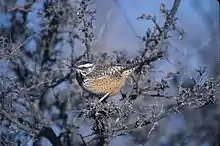 | |
| Cactus wren (Campylorhynchus brunneicapillus) | |
| Scientific classification | |
| Domain: | Eukaryota |
| Kingdom: | Animalia |
| Phylum: | Chordata |
| Clade: | Dinosauria |
| Class: | Aves |
| Order: | Passeriformes |
| Family: | Troglodytidae |
| Genus: | Campylorhynchus Spix, 1824 |
| Type species | |
| Opetiorhynchus turdinus[1] zu Wied-Neuwied, 1821 | |
Taxonomy
A 2007 genetic study established the following relationships between species, including some selected subspecies:[2]
| Campylorhynchus |
| ||||||||||||||||||||||||||||||||||||||||||||||||||||||||||||||||||||||||||||||||||||||||||||||||||||||
Species
Notes
- A binomial authority in parentheses indicates that the species was originally described in a genus other than Aviceda .
References
- "Treoglodytididae". aviansystematics.org. The Trust for Avian Systematics. Retrieved 2023-07-15.
- Barker, F. Keith (2007-04-01). "Avifaunal interchange across the Panamanian isthmus: insights from Campylorhynchus wrens". Biological Journal of the Linnean Society. 90 (4): 687–702. doi:10.1111/j.1095-8312.2007.00758.x. ISSN 0024-4066.
- BirdLife International (2012). "Campylorhynchus zonatus". IUCN Red List of Threatened Species. 2012. Retrieved 26 November 2013.
- BirdLife International (2012). "Campylorhynchus griseus". IUCN Red List of Threatened Species. 2012. Retrieved 26 November 2013.
- BirdLife International (2012). "Campylorhynchus jocosus". IUCN Red List of Threatened Species. 2012. Retrieved 26 November 2013.
- "Campylorhynchus brunneicapillus". Integrated Taxonomic Information System. Retrieved 9 February 2006.
- BirdLife International (2012). "Campylorhynchus brunneicapillus". IUCN Red List of Threatened Species. 2012. Retrieved 26 November 2013.
- BirdLife International (2012). "Campylorhynchus fasciatus". IUCN Red List of Threatened Species. 2012. Retrieved 26 November 2013.
- BirdLife International (2012). "Campylorhynchus chiapensis". IUCN Red List of Threatened Species. 2012. Retrieved 26 November 2013.
- BirdLife International (2012). "Campylorhynchus megalopterus". IUCN Red List of Threatened Species. 2012. Retrieved 26 November 2013.
- BirdLife International 2016. Campylorhynchus rufinucha. The IUCN Red List of Threatened Species 2016: e.T103887340A94287792. https://doi.org/10.2305/IUCN.UK.2016-3.RLTS.T103887340A94287792.en. Downloaded on 29 June 2019.
- BirdLife International 2016. Campylorhynchus humilis. The IUCN Red List of Threatened Species 2016: e.T103887386A104216660. https://doi.org/10.2305/IUCN.UK.2016-3.RLTS.T103887386A104216660.en. Downloaded on 29 June 2019.
- BirdLife International 2016. Campylorhynchus capistratus. The IUCN Red List of Threatened Species 2016: e.T103887650A104216920. https://doi.org/10.2305/IUCN.UK.2016-3.RLTS.T103887650A104216920.en. Downloaded on 29 June 2019.
- BirdLife International (2012). "Campylorhynchus gularis". IUCN Red List of Threatened Species. 2012. Retrieved 26 November 2013.
- BirdLife International (2012). "Campylorhynchus nuchalis". IUCN Red List of Threatened Species. 2012. Retrieved 26 November 2013.
- BirdLife International (2012). "Campylorhynchus turdinus". IUCN Red List of Threatened Species. 2012. Retrieved 26 November 2013.
- BirdLife International (2012). "Campylorhynchus albobrunneus". IUCN Red List of Threatened Species. 2012. Retrieved 26 November 2013.
- BirdLife International (2012). "Campylorhynchus yucatanicus". IUCN Red List of Threatened Species. 2012. Retrieved 26 November 2013.
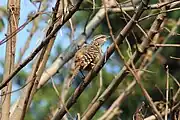

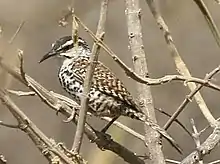
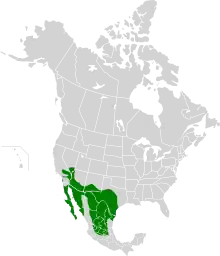

.jpg.webp)
.jpg.webp)
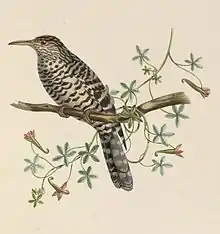
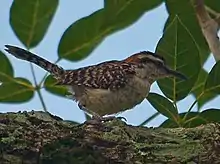
.jpg.webp)


